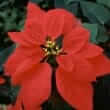Background
- There are over 2,000 species of Euphorbia in the world, ranging from annual weeds to trees. Most originate in Africa and Madagascar, and a significant percentage of these are succulent. All contain latex and have a unique flower structure.
- Native Americans used the plant for many medicinal purposes including treatment of skin infections (applied on the skin) and gonorrhea (internally). Traditionally, Euphorbia species have been used internally as laxatives and externally for rheumatism and skin conditions. However, nearly all the Euphorbias are poisonous and exude an acrid milky fluid when broken.
- Euphorbia is stated to possess antitussive, antifungal and antitumor properties. There is mixed evidence showing euphorbia's effectiveness for chronic bronchitis, eczema, epilepsy and oral inflammation. Small doses tend to be expectorant and diaphoretic. Larger doses produce emesis (vomiting) usually without much pain or spasm, nausea or dizziness. The roots and leaves of euphorbia are a strong laxative. Petty spurge sap has traditionally been used as a wart cure.
References
- Aya T, Kinoshita T, Imai S, et al. Chromosome translocation and c-MYC activation by Epstein-Barr virus and Euphorbia tirucalli in B lymphocytes. Lancet 5-18-1991;337(8751):1190.
View Abstract - Betancur-Galvis L, Checa J, Marco JA, et al. Jatrophane diterpenes from the latex of Euphorbia obtusifolia with inhibitory activity on the mammalian mitochondrial respiratory chain. Planta Med. 2003;69(2):177-178.
View Abstract - Corea G, Fattorusso E, Lanzotti V, et al. Discovery and biological evaluation of the novel naturally occurring diterpene pepluanone as antiinflammatory agent. J Med.Chem 11-3-2005;48(22):7055-7062.
View Abstract - Dai C, Yu B, Zhao Y, et al. [Correlation between inhibition activity of endophytic fungus from Euphorbia pekinensis and its host]. Ying.Yong.Sheng Tai Xue.Bao. 2005;16(7):1290-1294.
View Abstract - Feizbakhsh A, Bighdeli M, Tehrani MS, et al. Chemical constituents of the essential oil of Euphorbia teheranica Boiss., a species endemic to Iran. Journal of Essential Oil Research 2004;Jan/Feb
- Ferreira MJ, Gyemant N, Madureira AM, et al. The effects of jatrophane derivatives on the reversion of. Anticancer Res 2005;25(6B):4173-4178.
View Abstract - Hsueh KF, Lin PY, Lee SM, et al. Ocular injuries from plant sap of genera Euphorbia and Dieffenbachia. J.Chin Med.Assoc. 2004;67(2):93-98.
View Abstract - Miyata S, Wang LY, Yoshida C, et al. Inhibition of cellular proliferation by diterpenes, topoisomerase II inhibitor. Bioorg.Med.Chem 11-24-2005;
View Abstract - Natarajan D, Britto SJ, Srinivasan K, et al. Anti-bacterial activity of Euphorbia fusiformis-A rare medicinal herb. J Ethnopharmacol. 10-31-2005;102(1):123-126.
View Abstract - Osato T, Mizuno F, Imai S, et al. African Burkitt's lymphoma and an Epstein-Barr virus-enhancing plant Euphorbia tirucalli. Lancet 5-30-1987;1(8544):1257-1258.
View Abstract - Singh A, Singh SK. Molluscicidal evaluation of three common plants from India. Fitoterapia 2005;76(7-8):747-751.
View Abstract - Valadares MC, Carrucha SG, Accorsi W, et al. Euphorbia tirucalli L. modulates myelopoiesis and enhances the resistance of tumour-bearing mice. Int.Immunopharmacol. 2006;6(2):294-299.
View Abstract - Valente C, Pedro M, Ascenso JR, et al. Euphopubescenol and euphopubescene, two new jatrophane polyesters, and lathyrane-type diterpenes from Euphorbia pubescens. Planta Med. 2004;70(3):244-249.
View Abstract - Yin ZQ, Fan CL, Ye WC, et al. Acetophenone derivatives and sesquiterpene from Euphorbia ebracteolata. Planta Med. 2005;71(10):979-982.
View Abstract - Yu FR, Lian XZ, Guo HY, et al. Isolation and characterization of methyl esters and derivatives from Euphorbia kansui (Euphorbiaceae) and their inhibitory effects on the human SGC-7901 cells. J Pharm.Pharm.Sci. 2005;8(3):528-535.
View Abstract







